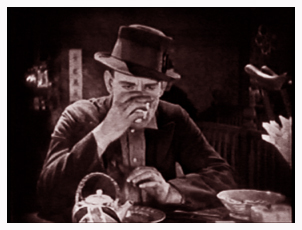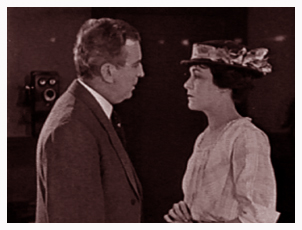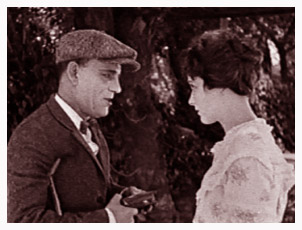

Production: Universal-Jewel
Released: June 10, 1923
Directed by Lambert Hillyer
Cast: Lon Chaney (Wilse Dilling), Virginia Valli (Gertrude Hadley), Jack Mower (Jack Cooper), William Welsh (Mischa Hadley), Henry Barrows (John Cooper, Sr.), Christine Mayo (Queen Ann), Harry Devere (Olaf Wismer), John Beck (Bill), Walter Long (The Captain), Robert Kortman (Henchman), Togo Yamamoto (Messenger at Restaurant)
Lon Chaney's "The Hunchback of Notre Dame" (1923)
and "The Phantom of the Opera" (1925), both from Universal,
are, without question, his most famous films. It seems, however,
that any other Chaney films that are revered today are all from
his tenure during the late 1920's at MGM. The reader should take
notice, though, that a 2002 release from the Blackhawk Films Collection
 (thanks to David Shepard) and released
by Image includes two excellent early Universals that deserve
renewed attention - "Nomads of the North" (1920) and
"The Shock" (1923). Unfortunately, this DVD release
is out of print, but used copies can be found through Amazon and
other sources at a very reasonable price.
(thanks to David Shepard) and released
by Image includes two excellent early Universals that deserve
renewed attention - "Nomads of the North" (1920) and
"The Shock" (1923). Unfortunately, this DVD release
is out of print, but used copies can be found through Amazon and
other sources at a very reasonable price.
This commentary will take a look at one of those films -- "The Shock," which, although a fairly standard melodrama, is taken to a higher level by the fine acting of Lon Chaney. One word of caution - if you have not seen this film, it is recommended that you view it before reading this commentary or any of the vintage reviews on the film that can be found on "Silents Are Golden." You will find that the viewing will be much more fun without knowing the details of the climax.
OK, that being said. Here goes.
Although a cripple who must get around with crutches, Wilse Dilling is a part of the San Francisco Chinatown underworld, led by the feared Queen Ann. Without explanation, Queen Ann orders Dilling to go to a small town, serve as the town's railway clerk, and await her instructions. While there, he is befriended by Gertrude Hadley, the beautiful daughter of Mischa Hadley who runs the local bank. He has never experienced such kindness, and this, along with the peaceful life of a small town in the countryside, transforms him, falling in love with Gertrude in the process. What Dilling doesn't know is that Queen Ann is planning to exact revenge on Gertrude's father who betrayed her many years ago and resulted in her serving prison time. She has blackmailed him over the years with some documents in her possession causing him to steal from his own bank to pay her. However, her plan now is to expose his embezzlement and see that he goes to jail. The day before the bank examiners are to come, Dilling blows up the bank hoping to save Hadley from disgrace. Unfortunately, Getrude has gone to the bank on that evening to find her father (who is not at the bank), and she is injured by the explosion, crippled just like Dilling. In San Francisco, she undergoes a successful operation to regain her ability to walk, but while there, Queen Ann manages to get Getrude in her clutches - the idea being to carry out her revenge on Hadley through his daughter. Dilling struggles to help and curses Queen Ann - but is helpless to succeed against the "queen" and her henchmen. The San Francisco earthquake of 1906 proves to be the Divine intervention that brings about a happy ending.
 Chaney's performances are always
first rate, and his portrayal of the cripple Wilse Dilling is
no less exceptional. The Harrison's Reports reviewer said,
"He is a cripple, and his ability to act as a cripple would
act in real life is a piece of art." (1) This exceptional
portrayal is evidenced throughout the film, but the viewer is
even more painfully aware of his limitations when he attempts
to regain the documents from Queen Ann's safe that will save Hadley.
Unfortunately, the safe is several feet above his head. The scene
extends for quite a while as we agonize with Dilling in his futile
efforts to devise a way to reach the safe. The tension of the
scene is enhanced as members of Queen Ann's gang watch him from
behind a curtain - almost certain to have the viewer gripping
his/her seat wondering what is going to happen next.
Chaney's performances are always
first rate, and his portrayal of the cripple Wilse Dilling is
no less exceptional. The Harrison's Reports reviewer said,
"He is a cripple, and his ability to act as a cripple would
act in real life is a piece of art." (1) This exceptional
portrayal is evidenced throughout the film, but the viewer is
even more painfully aware of his limitations when he attempts
to regain the documents from Queen Ann's safe that will save Hadley.
Unfortunately, the safe is several feet above his head. The scene
extends for quite a while as we agonize with Dilling in his futile
efforts to devise a way to reach the safe. The tension of the
scene is enhanced as members of Queen Ann's gang watch him from
behind a curtain - almost certain to have the viewer gripping
his/her seat wondering what is going to happen next.
Chaney gives a bravura performance at the climax as he has been caught at the Mandarin Cafe by Queen Ann and her gang. As if this weren't bad enough, she succeeds in bringing Gertrude to the cafe by intimidating Gertrude's spineless fiance, Jack, into calling her. Dilling drags himself from the floor, pulls himself up the counter and hanging on pleads, "Don't do it . . . God, man . . . don't let her get into their clutches." In a flash of anger, he thrusts himself from the counter toward Queen Ann but is thrown to the floor by one of her gang. When Gertrude is brought in, he continues to struggle to get up from the floor, but two of the gang throw him back each time, one threatening him with a knife. When they start to take Gertrude away, Dilling tries once more grabbing the gang member with the knife so he can go after Queen Ann, but again he is beaten down to the floor. The distress, mixed with anger, is an emotional high in the film, with his helplessness adding to the hopelessness of the situation.
Speaking of this high intensity sequence, Chaney biographer Michael Blake said, "Later, when he is held hostage in the restaurant of his boss, Chaney's emotional strength comes to the forefront. Cursing his former partners for harming the girl he loves, the actor embraces his character's hatred and elicits a powerful presence, his anger building, while he sits, crippled, on the floor." (2)
Blake also appropriately praises Chaney's acting in the finer details of his character. "Chaney applies subtle nuances to his character that give him a realistic appeal, such as in the opening of the film in which he is drinking tea at a Chinese restaurant. When he burns his tongue while attempting to sip hot tea, Lon winces. It appears he almost curses himself inwardly before blowing into the cup and attempting to drink again. This subtle but realistic touch gives a genuine flavor to his role." (3)
Blake went on to note that it was only "Chaney's performance" and the "mildly interesting special effects that simulate the 1906 earthquake" that distinguish this film from the other melodramas of the period - and this is true - and that, alone, would be enough to recommend this film to silent film fans. However, adding to Chaney's performance are some fine supporting players. Standing out among these is Christine Mayo as Queen Ann who is superb in the role of the underworld queen. A stoic, ruthless and totally dominating presence, she presents a cold demeanor when deciding the fate of Gertrude or dealing with disloyalty among her ranks. At almost 40 years old, Mayo was perfect for the part. Among the ranks of the forgotten today, she was a veteran actress with over 25 films to her credit dating back to 1914 before appearing in "The Shock." For whatever reason, she only made two more films after "The Shock" living to 77 years of age before passing away in 1961.
Virginia Valli is always an understated, yet beautiful,
presence in silent films. Her charming performance in "The
Shock" exudes the small town innocence of a young girl who
knows nothing of the seedier side
of life that Dilling has experienced. Her warmth, compassion and
beauty would no doubt transform the hardest criminal. Two films
later she was to provide one of her best performances in King
Vidor's "Wild Oranges" (1924), a must-see for any silent
movie fan. Retiring from films in 1930, she married Charles Farrell
in 1931 living the socialite's life in Palm Springs for the rest
of her life. She passed away in 1968 at age 72.
of the seedier side
of life that Dilling has experienced. Her warmth, compassion and
beauty would no doubt transform the hardest criminal. Two films
later she was to provide one of her best performances in King
Vidor's "Wild Oranges" (1924), a must-see for any silent
movie fan. Retiring from films in 1930, she married Charles Farrell
in 1931 living the socialite's life in Palm Springs for the rest
of her life. She passed away in 1968 at age 72.
Another virtual unknown, William Welsh, plays the father, Mischa Hadley, and does a commendable job as the overwrought, distressed bank manager who finds himself facing prison as a result of Queen Ann's blackmailing. He has some emotional scenes that are played extremely well, especially one in which Dilling comes to the bank late one night offering to help. Hadley, though, is terrified that bank examiners are coming the next day, doesn't trust Dilling when he learns Dilling is one of Queen Ann's gang, knocks Dilling to the floor and runs from the bank. Between 1912 and 1936, Welsh had 166 films to his credit passing away at the age of 76 in 1946.
The combination of fine acting by Chaney, excellent supporting players and a solid, if not exceptional, script, make this an enjoyable viewing experience. This said, it is interesting that the Variety reviewer blasted the film at the time. Referring to Chaney's performance in "The Miracle Man" (1919), the reviewer noted, "The subject missed by a wide margin the high aim of the other vehicle and degenerates into a cheap shocker. The punch is a mechanical reproduction of the San Francisco earthquake and fire, designed as a bit of sensational melodrama, but failing in its kick because there is no time when it is not evident to the spectator that the whole business is mere studio trickery. There is evidence that the cutting has been done with a heavy hand. The point of the story is that the cripple, Wilse Dilling, is miraculously made whole when he is crushed in a falling building while engaged in an effort to rescue the heroine from a band of criminals. The plausibility of the incident is spoiled by its inexpert management . . . The effect is substantiated as though all the important passages of the play took place off stage and the audience only heard them talked about. The system makes for unsatisfactory melodrama." (4)
The reference to Dilling's recovery being a result of the
building collapsing on him is puzzling as it seems the inference
in the film is that Dilling had the same operation that Gertrude
had to regain the use of her legs. Admittedly, this is not stated
explicitly, however, the Harrison's Reports reviewer is
in agreement with our interpretation of the film. "The hero's
deformity is corrected  by an effective operation,
after which he marries the heroine." (5)
by an effective operation,
after which he marries the heroine." (5)
The disparity in the opinion of the quality of the film between Harrison's Reports and Variety, two publications aimed at informing exhibitors, is stark. Harrison's Reports praised the film stating, "Another excellent melodrama with Mr. Chaney in the leading role, except that his part this time is more human, more sympathetic than any of those which he took in other pictures . . .The other characters, too, act their parts well. The San Francisco earthquake is reproduced with realism. The love affair between the hero and the heroine is portrayed so well that the spectator's sympathy is with them all the time."
We are also in agreement with the Harrison's Reports reviewer when he notes the earthquake scenes are reproduced well. Sure, they are miniatures, but recreated well, especially in the absence of modern day technology. The scene where Queen Ann's mansion falls from a cliff during the earthquake into the sea is particularly well-done. The Variety reviewer apparently fails to give credit to those shots that were done life-size (no doubt on a stage) where people in the street in front of the Mandarin Cafe are threatened by the collapsing building as it crumbles to the ground. The interior shots in the cafe during the earthquake with floors moving and ceiling falling are also extremely convincing.
"The Shock" is a Universal-Jewel meaning a little more time and money would have been lavished on it than the typical programmer. Nevertheless, studio head Carl Laemmle apparently wasn't satisfied writing to his recently named production chief Irving Thalberg in December 1922 wherein he expressed his disappointment in the picture. (7) Originally titled "Bittersweet," the film was to be released in February 1923 but was delayed for some unknown reason until June (did Laemmle order changes?). The film was directed by Lambert Hillyer who had directed Chaney four years earlier when he appeared in the William S. Hart feature "Riddle Gawne." It is interesting to note that Hart was well-known for his good-bad man character - seemingly always redeemed from his outlaw ways by the love of a good woman. The same theme is present in "The Shock," as well.
The Image DVD provides an excellent print of the film, tinted, good contrast, and running at 69 minutes. Produced by David Shepard, it does appear to have some intertitles that have been redone and don't exactly match the originals of the rest of the film; however, the original opening titles are there and always appreciated, along with another excellent score by Robert Israel. The addition of "Nomads of the North" on the disc makes the "two-fer" especially appealing.
References
1. "The Shock" review. Harrison's Reports. June
2, 1923.
2. Blake, Michael F. The Films of Lon Chaney. Vestal Press.
1998.
3. Ibid.
4. "The Shock" review. Variety. May 30, 1923.
5. Harrison's Reports.
6. Ibid.
7. Koszarski, Richard. An Evening's Entertainment: The Age
of the Silent Feature Picture, 1915-1928. University of California
Press. 1990.
Copyright 2014 by Tim Lussier. All rights reserved.